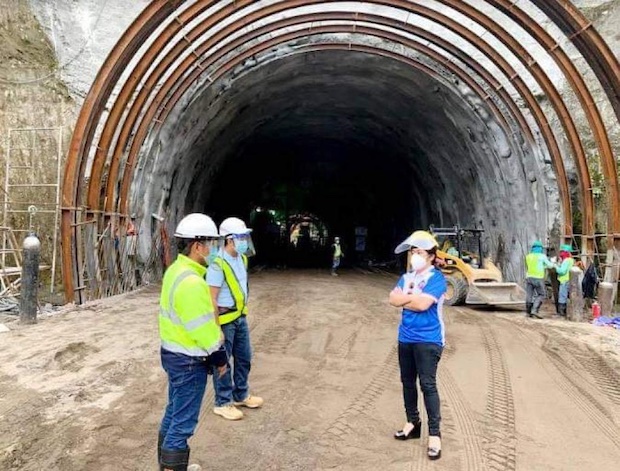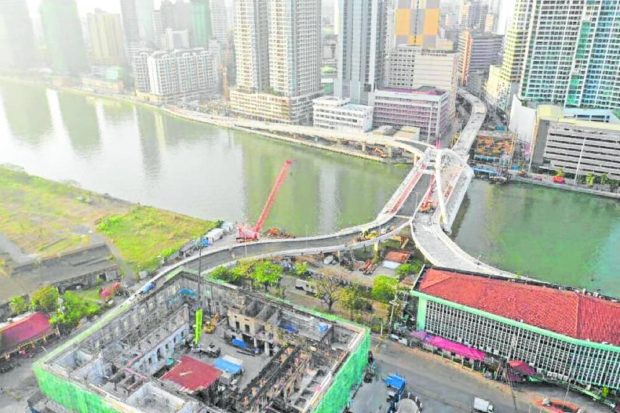Turning bold infra initiatives to reality

Sen. Mark Villar (left) with the author, Anna Mae Yu Lamentillo.
(First of two parts)
The “Build, Build, Build” (BBB) program under the administration of outgoing President Rodrigo Duterte is the country’s boldest, most ambitious infrastructure initiative in history. When it was launched, critics were quick to cite it as undoable and overly ambitious.
But in 2017, the first full year of the Duterte administration, the budget for infrastructure was already at 5.4 percent of the country’s gross domestic product (GDP), a two-fold increase compared to the past six administrations when average infrastructure spending was only at 2.4 percent of GDP.
Between 2016 and 2021, the Department of Public Works and Highways (DPWH) under the leadership of then Secretary Mark A. Villar completed a total of 29,264 km of roads; 5,950 bridges; 11,340 flood control projects; 222 evacuation centers; and 150,149 classrooms all over the country. It also provided jobs to 6.5 million Filipinos.
Vision into reality
Many of the computer-generated images that were once used to present a vision have already been turned into actual roads and bridges. Critics, however, continue to dismiss these achievements. They could not see the value of these infrastructure projects and how these have been benefitting Filipinos all over the country.
Article continues after this advertisementFor instance, the right-of-way problem that delayed the completion of Radial Road 10, spanned six presidents. The road traversing the old Smokey Mountain area was congested by informal settlers. It was only in January 2017 that the DPWH was able to complete the conversion of the 9.7-km road section into a high-capacity highway, which helped offset the usual heavy volume of vehicles in major thoroughfares like Edsa and C-5.
Article continues after this advertisementMoreover, the completion of the Skyway Stage 3 Project has reduced travel time between Makati and Quezon City from two hours to only 15 to 20 minutes; and between North Luzon Expressway (NLEx) and South Luzon Expressway (SLEx), from 2.5 hours to only 30 minutes.

Many of the computer-generated images that were once used to present a vision have already been turned into actual roads and bridges.
The Radial Road 10 and Skyway Stage 3 formed part of the Edsa Decongestion Masterplan, a network of infrastructure projects meant to connect the northern and southernmost parts of Metro Manila within a span of 20 to 30 minutes.
Countryside linkages
BBB projects are not concentrated in Metro Manila alone.
Of the 29,264 km of roads completed, only 877 km are in the National Capital Region. The Cordillera Administrative Region has 1,304 km of roads completed; 1,677 km in Ilocos Region; 1,645 km in Cagayan Valley; 2,701 km in Central Luzon; 2,012 km in Calabarzon; 1,310 km in Mimaropa; 1,769 km in Bicol Region; 2,193 km in Western Visayas; 1,685 km in Central Visayas; 1,548 km in Eastern Visayas; 1,817 km in Zamboanga Peninsula; 2,972 km in Northern Mindanao; 2,194 km in Davao Region; 2,125 km in Soccsksargen; and 1,435 km in Caraga.
From the onset, the goal of BBB is to create a road network that would not only link Luzon, Visayas and Mindanao, but would also bring together Filipinos. Once all 81 provinces, 146 cities and 1,489 municipalities are connected, the possibilities for development are endless. President Duterte’s Mega Bridge Project aims to turn this dream into reality.
The Mega Bridge Project is a series of short- and long-span bridges linking island provinces to eventually connect Luzon, Visayas and Mindanao via land travel. Part of this is the 3.169-km Panguil Bay Bridge which will connect the City of Tangub in Misamis Occidental to the Municipality of Tubod in Lanao del Norte.
At present, travel time from Tangub City to Tubod is 2.5 hours via the 100-km Tangub-Molave-Tubod Road or via Tangub-Kapatagan-Tubod Road. Once the Panguil Bay Bridge is completed by December 2023, travel between these two areas will only take seven minutes. (To be continued)The author is the former chairperson of the Build, Build, Build Committee under the Department of Public Works and Highways